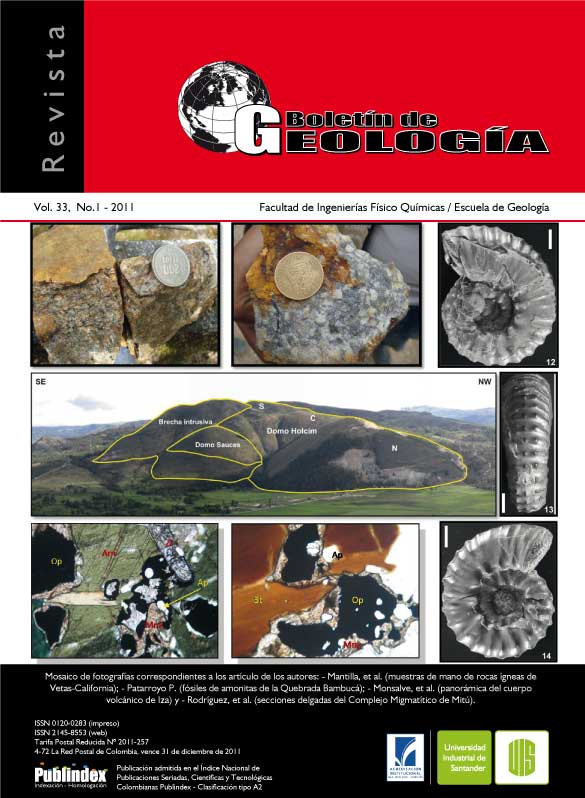GEOLOGICAL CARACTERIZATION OF IZA VOLCANIC STRUCTURE,BOYACÁ - COLOMBIA
Published 2012-02-20
How to Cite
Abstract
Iza volcanic structure (5°36’20’’N – 72°59’33’’ W) is the result of rising riodacitic to ryolithicmagmatic pulses, which didn´t reach the surface, the first of them giving origin to an intrusive breccias, interpreted as the result of indirect hot deep magma interaction with a sedimentary aquifer, leading to vapor overpressure and consequent fragmentation of the host rocks. The intrusive brecciaform the Southern part of the Iza edifice, it is massive beige to light red in color, locally with pseudocolumnar joint; it is composed by angular to subrounded sedimentary and minor igneous rock fragments in a porphyry rhyotlitic matrix. This stage is followed by dome emplacement which a redacitic to rhyolitic in composition. Petrographic analisys show that they are similar to the matrix breccia; they have a porphiritic texture, phenocrist of sanidine, quartz and plagioclase and glassymatrix. Locally the domes are fractured presenting breccias facies (autobreccia and Jig saw breccias,among others). Relationship with the host rock allow to interpreting the volcanic body as a cryptodomes,outcropping at surface by faulting and erosion.
Keywords: Iza, Intrusive Breccias, Dome, Cryptodome.
Downloads
References
Cas, R. A. F. and Wright, J. V. 1982. Modern and Ancient volcanic successions: An approach to analysis of facies, environments of deposition and tectonic setting. Departament of Earth Sciences, Monash University. England.
Cepeda, H. y Pardo, N. 2004. Vulcanismo de Paipa. INGEOMINAS, Proyecto exploración y evaluación de los recursos geotérmicos. Reporte interno. Bogotá, 103p
Contreras-Fayad, D.A. 2008. Caracterización mineralógica de rocas que componen el cuerpo volcánico que Aflora en Cercanías al Municipio de Iza, Boyacá, Colombia. Petrografía, metalografía y análisis elemental por Medio de un Microscopio Electrónico de Barrido. Universidad Nacional de Colombia, Bogotá, 38p
Fink, J.H, 1993. The emplacement of silicic lava flows and associated hazards. In: Active Lavas, C.J. Kilburn and G. Luongo (Eds.), University College London Press, pp. 5-24
Fink, J.H., Malin, M.C., and Anderson, S.W. 1990. Intrusive and extrusive growth of the Mount St Helens lava dome. Nature, 348: 435-437
Goto, Y., Kano, S., Tuchiya, N., and Nakatsuka, K. 2000. Internal structures and fracture networks in a Miocene dacite intrusion Rebun island Hokkaido, Japan. Proceedings World Geothermal Congress, pp. 3713-3718
Goto, Y.,Ito, Y.,Yokoyama, Y., Matsui, T., and Mimatsu, S. 2004. Internal structures of a subaerial dacite cryptodome at Usu volcano, Hokkaido, Japan. Mem. Muroran Inst. Tech., 54: 3-10
Goto, Y. and McPhie, J. 1998. Endogenous growth of a Miocene dacite cryptodome, Rebun Island, Hokkaido, Japan. J. Volcanol. Geotherm. Res., 84: 273-286
INGEOMINAS. 1995. Compilación de los estudios geológicos oficiales en Colombia: Estudio de reconocimiento de los recursos geotérmicos de la República de Colombia (Olade Geotérmica Italiana), Tomo XXI. 455p.
IRME-UPTC. 2000. Estudio de prefactibilidad para definir zonas de depósito para estériles de la mina de puzolana en Iza (Boyacá). Cementos Boyacá. Sogamoso, 110p.
Jaramillo, J. M., Rojas, P., and Garver, J. I. 2005. Pliocene volcanism in the Cordillera Oriental of Colombia. 6th International Symposium on Andean Geodynamics. Barcelona, Extended Abstracts, pp. 411-412
Martinez, A. 1989. Geologie de la región d’Iza, Boyaca. Cordillere orientale de Colombie. Diplome de mineralogie et Geologie, Universite de Laussanne, 52p
Pardo, N. 2004. Estratigrafía de las vulcanitas asociadas al volcán de Paipa, municipios de Paipa y Tuta, Departamento de Boyacá, Colombia. Trabajo de grado. Universidad Nacional de Colombia- Bogotá. 163p
